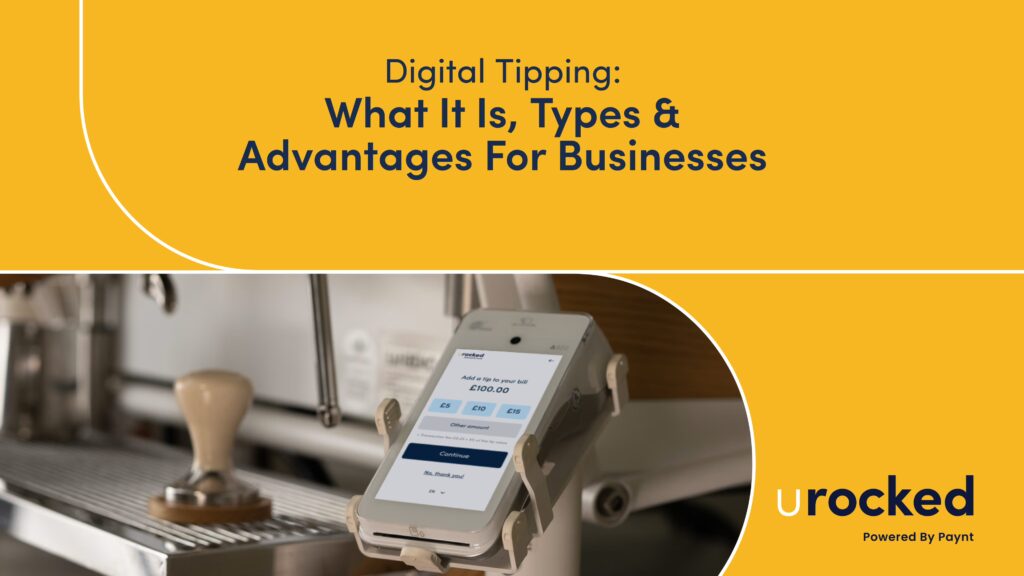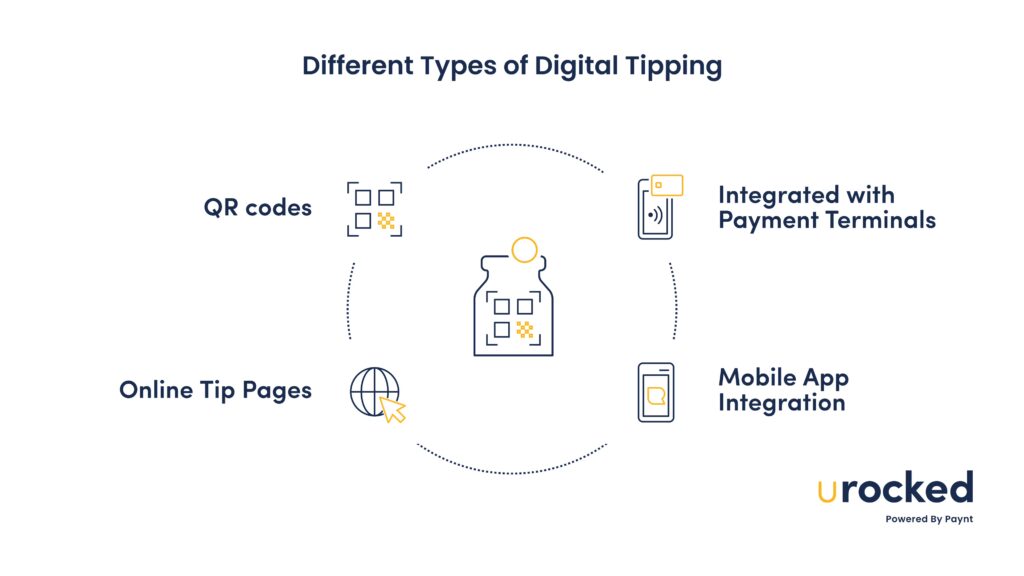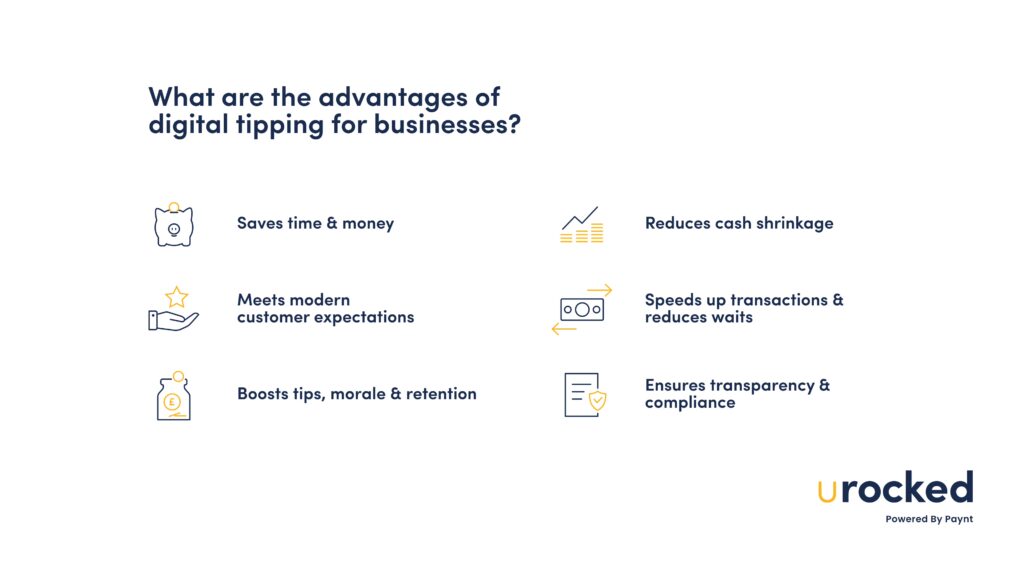

Digital tipping is a digital method that enables customers to leave tips to service workers using digital platforms such as QR codes, contactless terminals, online pages and mobile apps without using cash. Digital tipping has become increasingly important in the hospitality industry as it provides a convenient method to tip for good service in restaurants, bars and other service based businesses.
This tipping method benefits businesses through faster transactions, reduced cash risks, compliance, and staff retention. Employees receive secure, timely payouts with transparent records. Solutions include QR-based tipping, mobile app integration, online tip pages, and POS systems. Businesses should consider ease of use, payout speed, security, vendor reliability, and cost when selecting a platform.
In this article we discuss what is digital tipping, the different types of digital tipping, how it works and the advantages for businesses and employees.
Digital tipping, also known as cashless tipping, is a digital method that enables customers to leave tips to service workers using digital platforms such as QR codes, contactless terminals, online pages and mobile apps without using cash. Digital tipping typically prompts customers for tips after completion of a service, such as when a diner settles their bill electronically. This method provides a fast, simple way for customers to tip in one transaction with the bill or in instances where they do not carry any physical cash. Customers have the option to pay digitally with the use of debit / credit cards, digital wallets and direct bank transfers.
Digital tipping has become increasingly important in the hospitality industry as it provides a convenient method to tip for good service in restaurants, bars and other service based businesses. There are many benefits for businesses such as saving time and money, satisfying modern consumer expectations, higher tips improving staff morale and retention, less cash shrinkage, faster transactions and reduced wait times, and transparency and compliance.
Cashless payments have become the most popular method of transacting in the UK with card payments (debit and credit) accounting for 61% of all payments in 2023 according to UK Finance in the UK Payments Market Summary 2024. Contactless debit and credit card payment represented 38% of all UK payments in 2023 according to the same UK Finance study. This shows the importance of digital tipping as a tip payment method following the payment preferences of consumers.
A digital tipping solution is a technology platform that enables businesses and service providers to facilitate electronic tip transactions through integrated software and hardware systems. This solution uses digital payment methods such as QR codes, mobile apps, or online platforms to complete tip transactions instead of using cash. Digital tipping solutions typically comprise several components including payment processing software, customer-facing interfaces such as QR code generators and POS terminals.
Advanced digital tipping platforms feature backend systems for tip distribution and reporting, mobile apps for customers and service providers, and APIs that integrate with point-of-sale and payroll platforms.
Digital tipping solutions typically offer features such as customisable tip suggestions, automated tip pooling and distribution, real-time earnings dashboards for workers, detailed analytics for business owners, and compliance tools for tax reporting. These solutions primarily serve restaurants, hotels, salons, ride-sharing services, food delivery platforms, and personal service providers. Digital tipping platforms are typically compliant with tipping laws such as the Employment (Allocation of Tips) Act 2023 in the UK.

There are four main types of digital tipping solutions including QR Codes, online tip pages, mobile payment apps, and POS-Integrated Tipping Solutions. The different types of digital tipping solutions are discussed below:
QR Code Tipping Solutions are digital tipping systems that enable customers to provide digital tips by scanning Quick Response codes with their mobile devices. This system uses QR code technology to generate unique codes and redirect customers to mobile-optimised payment pages without app downloads. QR code tipping solutions process mobile payments through secure payment gateways and support various payment methods including credit cards and digital wallets.
Online tip pages are digital platforms that allow supporters or customers to send digital tips to individuals or businesses. This solution functions as a virtual tip jar where users pay tips by visiting a website or unique link. This digital solution provides a convenient way for content creators, service workers or businesses to generate additional revenue, wages or donations for projects.
Mobile app tipping integrations are digital tipping solutions that enable customers to send tips directly within the mobile app as part of their overall purchase. This solution is popular with food delivery or ride-sharing services. These mobile apps utilise secure payment processing systems that enable customers to select tip amounts, and complete transactions through the app interface.
POS-Integrated tipping solutions are digital tip solutions built directly into point-of-sale hardware and software that enable customers to add tips during payment. This solution uses existing payment terminals and merchant processing systems to display tip options during card transactions. POS-integrated tipping solutions can initiate tipping prompts on payment screens or a customer-face display panel.
This tipping solution enables combined bill and tip payments using contactless cards, chip-and-PIN, and magnetic stripe transactions. Contactless payment functionality supports mobile payments through digital wallets including Apple Pay, Google Pay, and Samsung Pay.
Digital tipping works by using technology such as QR codes, card machines, mobile apps or payment links to allow customers to pay tips digitally using cards or digital wallets at the point of sale or online. The process begins when customers scan a QR code, click a payment link or choose tip amounts on an interface such as a card machine or a mobile application. For QR codes and online webpages customers are redirected to a secure digital payment interface where they can select preset tip percentages or enter custom amounts.
Digital tipping uses sophisticated payment gateways that process transactions through multiple channels, including credit and debit cards, Apple Pay, Google Pay, and direct bank transfers. These systems employ tokenisation technology to encrypt sensitive payment data, ensuring secure fund transfers whilst maintaining PCI DSS compliance standards. The digital tipping platform automatically routes funds to designated accounts once the payment is authorised. Advanced algorithms distribute tips amongst multiple staff within a tip pooling arrangement. The tips are distributed based on hours worked by staff, specific job roles and location.
The digital tipping platform automatically records the tip payment in real-time using cloud-based systems and routes funds to designated accounts. The tips are then sent directly to individual accounts or sent to a central tip pool. Advanced digital tipping platforms can distribute tips based on hours worked by staff, specific job roles and location.
These digital tipping platforms have scheduled payouts within a few days, weekly or monthly cycles. Many platforms integrate directly with existing payroll systems to streamline tax reporting and ensure compliance with employment regulations. Customers and staff benefit from real-time transparency features, with customers receiving immediate confirmation of their tip and workers accessing live earnings dashboards through mobile applications.
Restaurants pay out credit card tips by capturing tip amounts through POS systems and then distributing them either through payroll or immediate cash payments. The process begins when customers add tips through the POS terminal which records tip amounts with meal costs and sends the data to payment processors through secure payment gateways. POS systems typically use integrated software to separate tips from food sales and track individual or pooled gratuities based on the restaurant’s distribution model. Restaurants without integrated software use a manual process to record tip amounts and prepare them for staff allocation.
Credit card transactions are batch-processed at the end of each business day when restaurants close payment terminals and send aggregated sales and tip data to processors. Payment settlement occurs within 1–3 business days as processors deposit combined sales and tip amounts into the restaurant’s merchant account. During settlement, POS software tracks tips and allocates specific amounts to employees or tip pools based on service assignments and shift schedules.
Restaurants distribute credit card tips through several methods including payroll system integration with tax deductions, cash payouts from tills, or direct deposits that transfer tips separately from payroll into employee accounts. Modern tipping systems typically ensure compliance by distributing full tip amounts to staff, paying tips promptly, and documenting distributions for regulatory audits.
Yes, employees receive digital tips through automated payment systems that transfer gratuities directly to worker accounts. Modern digital tipping platforms integrated at the point of sale automatically calculate the tip amounts due to staff and then process tip payments through secure payment gateways and distribute funds to employee bank accounts.

The advantages of digital tipping for businesses include saving time and money, satisfying modern consumer expectations, higher tips improving staff morale and retention, less cash shrinkage, faster transactions and reduced wait times, and transparency and compliance. The advantages of digital tipping for businesses are listed below:
The advantages of digital tipping are listed below:
To choose the best digital tipping solution for your business, consider your business needs, ease of use for customers and staff, speed and flexibility of payouts, security, tipping law compliance, vendors reputation and cost. How to choose a digital tipping solution are outlined in the seven steps below:
Step 1: Assess Your Business Needs
Choosing the right digital tipping setup for your business depends on specific factors such as staff size, existing technology systems, and the type of service business. Different types of businesses such as restaurants, hotels, and pubs may need more complex digital tipping systems that add tips to bill payments.
Large businesses with extensive staff may need digital tipping platforms with automated distribution systems to manage multiple employees efficiently across different roles, hours worked and business locations.
Step 2: Consider Ease of Use for Customers and Staff
The chosen digital tipping solution should be easy to use for customers and staff. A clear, intuitive interface that lets customers tip quickly improves transparency and can increase tip frequency and amounts.
Easy-to-use software helps staff prompt for tips conveniently during payment in a timely manner. A digital tipping platform with clear dashboards helps management track and allocate tips, saving time and improving efficiency.
Step 3: Choose a system with Fast Payouts and automated distribution
Select digital tipping solutions that collect, calculate, and automate tip distribution to staff in a timely manner. Solutions that offer fast and automated distribution platforms with regular payout schedules ensure staff receive tips promptly instead of waiting for monthly payrolls.
The solution should be flexible to incorporate tips being paid directly to individual staff and to the team tip pool. For example, URocked’s tipping platform pays out tips every Monday, Wednesday and Friday and calculates tip allocations for hours worked, different job roles and by location.
Step 4: Consider Security Features
A digital tipping platform should incorporate security features including data encryption, PCI compliance, and secure payment processing to protect customer payment information and employee earnings. Consider vendors that implement fraud controls and the capacity to handle large volumes of transactions.
Step 5: Choose a compliant digital tipping solution
The digital tipping solution should comply with the Employment (Allocation of Tips) Act 2023, ensuring staff receive all tips and service charges without employer deductions. Tips should be paid to staff no later than the end of the following month after collection. The system should provide staff with access to transparent reporting on tip transactions and detailed breakdowns of individual earnings.
Step 6: Identify the Best Digital Tipping Solutions Vendors
Evaluate digital tipping providers by reputation, support quality, implementation help, and ongoing service reliability. Identify vendors that provide onboarding support, staff training, and technical assistance for adopting the new digital tipping system.
Step 7: Consider the cost to the business
Compare vendor pricing structures and fees for every transaction. Consider contract terms and the setup cost to implement the new technology within your business.
The best digital tipping solution for restaurants is a POS-integrated tipping system that enables customers to add tips during card payments. Restaurant digital tipping solutions should integrate seamlessly with existing point-of-sale systems, be easy to use for both customers and staff and support high transaction volumes during peak periods. The tipping solution should provide automated tip distribution with transparency to both staff and management.
The best digital tipping solution typically accommodates flexible tip pooling that factors hours worked and different job roles such as servers, kitchen teams, and support staff. A tipping solution for restaurants should comply with the Employment (Allocation of Tips) Act 2023, the tipping regulation in the UK.
Solutions like URocked are popular because restaurants can accept the bill and tip in the same transaction on a POS terminal. The terminal is easy to use for staff and customers to prompt and provide tips using the intuitive interface. The tipping solution is compliant with the Employment (Allocation of Tips) Act 2023, has weekly tip payout runs every Monday, Wednesday and Friday ensuring staff are paid in a timely manner. URocked enables individual staff tips and team tip pooling with automated tip distribution and transparent reporting for management and staff.
The best digital tipping solution for hotels is a platform that is easy for guests to use throughout the hotel premises for different services and staff. The solution should provide convenience to the guest in the method of payment such as NFC tap to pay on POS terminals, QR codes, and paying tip alongside the bill on card machines. A hotel digital tipping solution should be widely available and accessible on QR codes displays, tap-to-tip displays and tipping capability on all POS terminals within the premises.
The best digital tipping solution typically accommodates flexible tip pooling that factors hours worked and different job roles such as housekeeping, room service, valet, and restaurant staff . A tipping solution for hotels should comply with the Employment (Allocation of Tips) Act 2023, the tipping regulation in the UK.
Solutions like URocked are popular because hotels can implement QR codes and contactless POS terminals that enable guests to tip hotel service staff directly. The platform is compliant with the Employment (Allocation of Tips) Act 2023, has weekly tip payout runs every Monday, Wednesday and Friday ensuring timely staff payments. URocked enables individual staff recognition and departmental tip pooling with automated distribution and transparent reporting for both management and staff across different hotel service areas.
The best digital tipping App for tour guides is a mobile-friendly platform that enables tourists to tip easily through QR codes without requiring cash. Tour guide digital tipping apps should support the use of foreign cards, and provide instant payment processing.
Solutions like URocked are popular because tour guides can share QR codes that enable tourists to tip conveniently through their smartphones using foreign cards. The platform has weekly tip payout runs every Monday, Wednesday and Friday ensuring timely payments.
URocked enables individual guide recognition and group tip collection with automated distribution and transparent reporting, allowing tourists to tip specific guides who led their tours whilst providing tour operators with clear oversight of tip allocation across different guides and tour experiences.